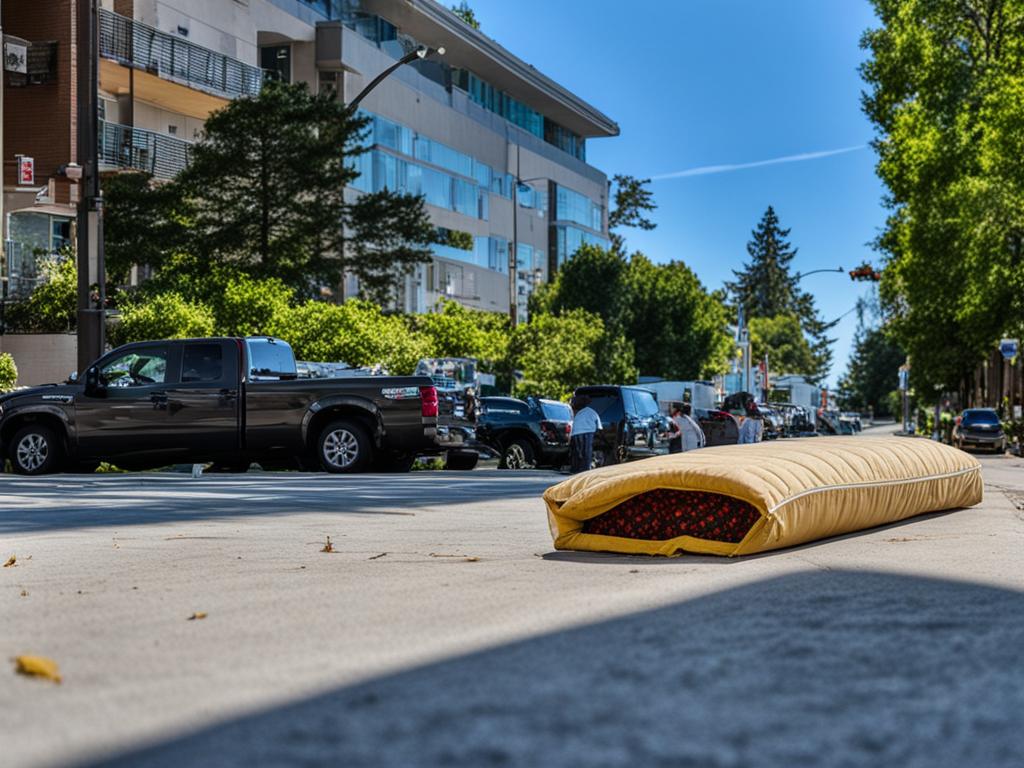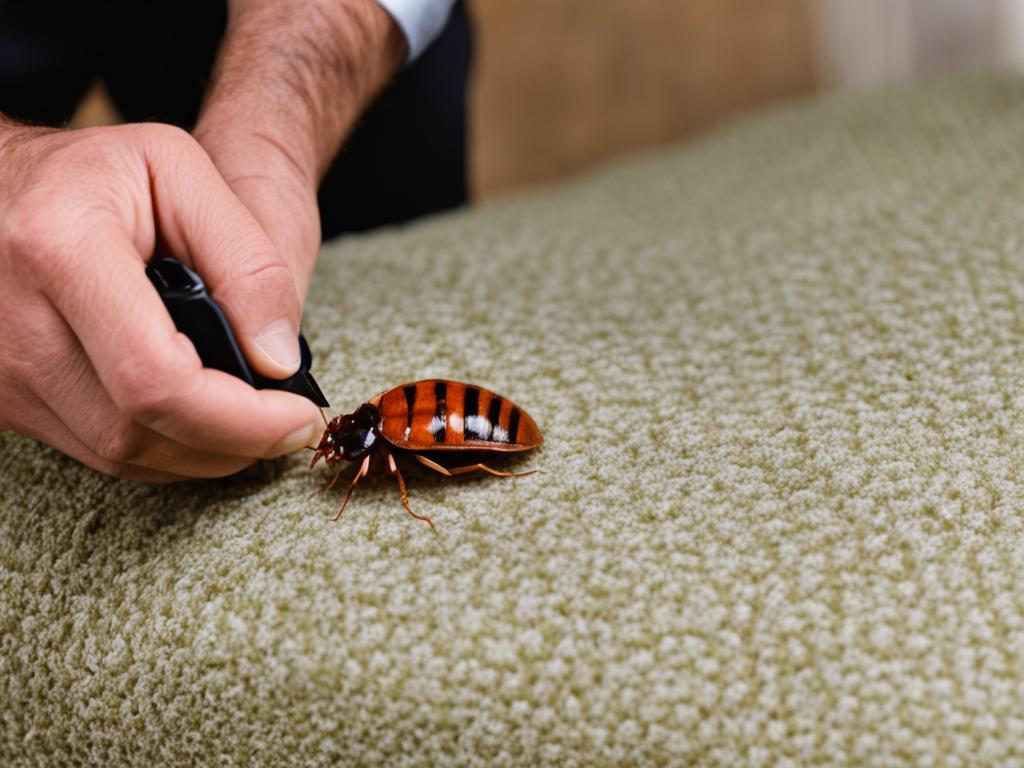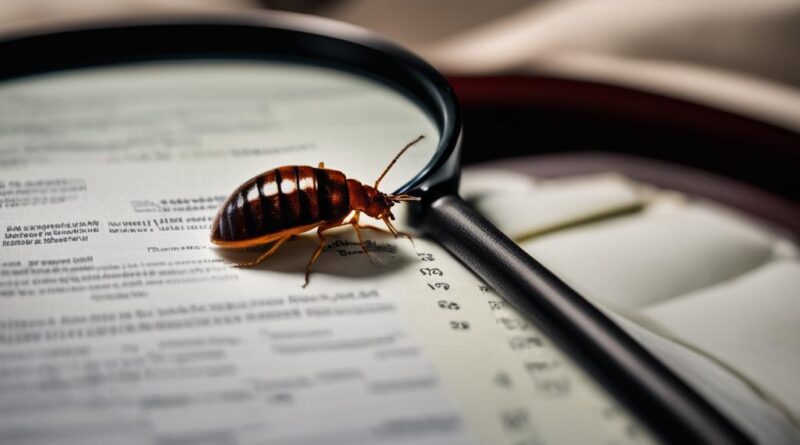Proving Tenant Brought Bed Bugs: A Guide
Dealing with a bed bug infestation is a nightmare for both landlords and tenants. If you’re a landlord and suspect that a tenant is responsible for introducing bed bugs to your property, you may be wondering how to prove it. The burden of proof lies with the landlord, but it can be a challenging task due to the elusive nature of bed bugs and the difficulty in pinpointing the exact source of the infestation.
However, with the right evidence and documentation, you can strengthen your case and hold the tenant responsible for the cost of extermination. In this guide, we will explore the steps landlords need to take to prove tenant responsibility for bed bugs and highlight the essential practices for preventing and controlling these pesky pests.
Key Takeaways:
- Proving tenant liability for a bed bug infestation requires concrete evidence.
- Understanding bed bug behavior and their lifecycle can help in identifying infestations.
- Bed bugs are difficult to get rid of due to their ability to hide and resistance to pesticides.
- Landlords should fulfill their responsibilities in maintaining a habitable environment.
- Tenants also have responsibilities in preventing and reporting bed bug infestations.
Understanding Bed Bugs and Their Behavior
Bed bugs are small, oval-shaped insects that are reddish-brown in color. They spend their days hiding in cracks and crevices, including mattresses, and come out at night to feed on human blood. Their bites can cause itching and welts in some individuals. Bed bugs have a lifespan of 10-11 months and can lay several eggs a day, which are hard to detect due to their small size. It is essential to be able to identify the signs of a bed bug infestation in order to prove tenant responsibility.
Signs of Bed Bug Infestation:
- Blood stains on sheets and mattresses
- Fecal spots
- Presence of live bugs or shed skins
To better understand the behavior of bed bugs, let’s take a closer look at their life cycle.
Bed Bug Life Cycle
| Stage | Description |
|---|---|
| Egg | Small, approximately 1mm in size |
| Nymph | Immature bed bug that goes through five stages before becoming an adult |
| Adult | Reddish-brown in color, about the size of an apple seed |
The bed bug life cycle can take anywhere from 4-7 weeks depending on environmental conditions. They require a blood meal at each stage to molt and progress to the next. The ability of bed bugs to reproduce rapidly makes it crucial to detect and address infestations early on.
Now that we have a basic understanding of bed bug behavior and their life cycle, let’s explore how to detect a bed bug infestation.
Why Bed Bugs Are Difficult to Get Rid Of
Bed bugs can pose a significant challenge when it comes to eradication for several reasons. These resilient pests have developed various adaptations that make them hardy and difficult to eliminate completely.
Challenges of Bed Bug Removal
- Hidden Havens: Bed bugs are masters of concealment, able to hide in the tiniest cracks and crevices. From behind wallpaper to within electrical outlets, these pests can evade detection and treatment, prolonging the infestation.
- Resistance to Pesticides: Over time, bed bug populations have developed resistance to many commonly used pesticides. This resistance compromises the effectiveness of chemical treatments, making it harder to control infestations.
- Elusive Origins: Determining the exact source of a bed bug infestation can be an arduous task. These pests are adept at hitchhiking on clothing, furniture, luggage, and other personal belongings, making it challenging to pinpoint whether the tenant or someone else introduced them to the property.
These challenges not only make bed bug removal a complex process but also pose difficulties in proving tenant responsibility for the infestation. However, it is crucial to gather substantial evidence to support your claim when seeking to hold tenants liable for the cost of extermination.
“Bed bugs are a highly resilient pest that can hide in the smallest of places, making their eradication a formidable task.”

Understanding the challenges involved in bed bug removal is essential for landlords in their efforts to address infestations effectively. By staying informed and implementing comprehensive strategies, you can improve your chances of successfully eliminating these persistent pests.
Best Practices for Bed Bug Prevention
Preventing bed bug infestations in rental properties is crucial to maintain a safe and comfortable living environment. By implementing best practices and educating tenants on preventive measures, landlords can reduce the risk of bed bug introductions and minimize the cost of extermination.
Regular Inspections
Regular inspections are an essential part of preventing bed bug infestations. Consider utilizing detection dogs to identify early signs of bed bugs, even before they become visible to the naked eye. These trained canines have a superior sense of smell and can detect bed bug presence with high accuracy.
Tenant Reporting
Encouraging tenants to report any signs of bed bugs promptly is crucial for early detection and intervention. Create an open and supportive environment where tenants feel comfortable reporting infestations. Respond to tenant concerns promptly and take appropriate action to prevent the spread of bed bugs.
Education and Awareness
Empower tenants with knowledge on how to prevent bed bug infestations. Provide educational materials, such as brochures or flyers, that outline bed bug prevention tips. This can include recommendations such as regular vacuuming, sealing cracks and crevices, and being cautious with used furniture.
Bed Bug Protectors
Encourage tenants to use bed bug protectors for mattresses and box springs. These protective covers create a barrier, preventing bed bugs from hiding or breeding in these areas. Regularly inspect the protectors for any signs of bed bugs, such as blood stains or fecal spots.
Tenant Policies
Establish clear policies that promote tenant reporting of bed bugs. Communicate the importance of early detection and explain the procedures for reporting infestations. By creating a culture of responsibility, tenants will be more inclined to report any signs of bed bugs promptly.
By following these best practices, landlords can significantly reduce the risk of bed bug infestations in rental properties. Remember, prevention is key to maintaining a pest-free environment and ensuring the well-being of tenants.
Common Bed Bug Prevention Tips
| Prevention Tips |
|---|
| Vacuum regularly to remove any potential bed bugs. |
| Encase mattresses and box springs in bed bug protectors. |
| Inspect used furniture carefully before bringing it into your home. |
| Seal cracks and crevices in walls, baseboards, and furniture. |
| Keep the living space clean and clutter-free. |
| Report any signs of bed bugs to the landlord immediately. |
| Avoid storing items under the bed, as it provides a hiding spot for bed bugs. |
| Inspect your luggage and bags after traveling. |
Proving Tenant Liability for Bed Bugs
When it comes to proving tenant liability for a bed bug infestation, gathering substantial evidence is crucial. Landlords need to document any actions or inaction by the tenant that could have led to the introduction of bed bugs into the property. This includes collecting proof that the tenant brought in infested items or failed to cooperate with pest removal services.
The burden of proof lies with the landlord, as they need to demonstrate that the infestation was a result of the tenant’s actions or negligence. However, meeting this burden can be challenging due to the difficulty in pinpointing the exact source of the infestation and tenants potentially hiding the problem to avoid responsibility.
To strengthen their case, landlords should keep detailed records of any communication with the tenant regarding the infestation and their refusal to cooperate. Documenting instances where the tenant brought in infested furniture or failed to prepare the unit for pest removal services can also be valuable evidence.
“As a landlord, it’s essential to gather as much evidence as possible to support your claim of tenant responsibility for a bed bug infestation. This evidence can include photographs, communication records, and testimonies from pest removal professionals.”
Cooperation with reputable pest removal services is crucial in proving tenant liability. Landlords should work closely with these professionals to document the extent of the infestation, the steps taken to treat it, and the tenant’s cooperation or lack thereof.
Overall, achieving a successful outcome in proving tenant liability for bed bugs requires diligence, thorough documentation, and cooperation with pest removal services. By collecting compelling evidence, landlords can increase their chances of recovering the costs associated with extermination and holding the responsible tenant accountable.
Responsibilities of Landlords in Bed Bug Control
As a landlord, it is your responsibility to ensure that your rental properties are free from bed bug infestations. By fulfilling your obligations, you can create a safe and comfortable living environment for your tenants. Here are some key responsibilities that you should prioritize:
Prompt Response to Complaints
When a tenant reports a potential bed bug infestation, it is crucial to respond promptly. Addressing the issue in a timely manner not only shows your commitment to tenant satisfaction but also helps prevent the infestation from spreading to other units. Prompt response demonstrates your dedication to resolving the problem and maintaining a clean and pest-free environment for all occupants.
Regular Inspections
Regular inspections play a vital role in identifying early signs of bed bug infestations. By conducting periodic inspections, you can detect any issues before they escalate, allowing for swift intervention and minimizing the cost of extermination. Inspections enable you to identify the source of the infestation and take necessary measures to hold responsible parties accountable.
Prevention Measures
Implementing preventive measures is key to reducing the risk of bed bug introduction and spread in your rental properties. By proactively taking steps to prevent infestations, you demonstrate your commitment to providing a comfortable living environment. Prevention measures include educating tenants about bed bug prevention, conducting regular cleaning, implementing policies regarding secondhand furniture, and sealing cracks and crevices that could serve as hiding places for bed bugs.
Remember, by fulfilling your responsibilities as a landlord, you not only protect your investment but also maintain tenant satisfaction and well-being.

Summary of Landlord Responsibilities in Bed Bug Control
| Responsibilities | Description |
|---|---|
| Prompt Response to Complaints | Address tenant complaints about bed bug infestations in a timely manner to prevent further spread. |
| Regular Inspections | Conduct regular inspections to identify early signs of bed bug infestations and take necessary action. |
| Prevention Measures | Implement preventive measures, such as educating tenants, conducting regular cleaning, and sealing entry points. |
Responsibilities of Tenants in Bed Bug Control
Tenants also have important responsibilities when it comes to preventing and controlling bed bug infestations. By being proactive and cooperative, tenants can help maintain a clean and pest-free living environment for themselves and their neighbors. Here are some key tenant responsibilities to keep in mind:
1. Reporting Bed Bug Infestations
It is crucial for tenants to promptly report any signs of a bed bug infestation to their landlord or property management. This includes noticing bites, blood stains on sheets, fecal spots, or the presence of live bugs in their rental unit. By reporting the infestation early on, tenants can prevent further spread and help the landlord take appropriate action.
2. Preventing the Spread of Bed Bugs
Tenants should take proactive measures to prevent the spread of bed bugs to other units. This includes properly laundering bedding and clothing at high temperatures to kill any potential bed bugs. It is also essential to avoid bringing in infested furniture or other items into the rental unit.
3. Cooperating with Extermination Efforts
When a bed bug infestation occurs, tenants must cooperate fully with the extermination efforts. This includes following any instructions provided by the landlord or pest control professionals, such as preparing the unit for treatment, moving furniture if necessary, and allowing access to the premises as needed.
Tenants should also take measures to ensure that the extermination is successful, such as vacuuming regularly to remove any hiding bed bugs or eggs and properly disposing of vacuum bags. By actively participating in the extermination process, tenants can help eliminate the infestation more effectively.
4. Keeping the Rental Unit Clean and Decluttered
Maintaining a clean and clutter-free rental unit is essential in preventing and controlling bed bug infestations. Regularly cleaning and decluttering the living space creates fewer hiding spots for bed bugs and makes it easier to detect any signs of infestation. Tenants should also take care to seal cracks and crevices where bed bugs can hide, such as gaps in walls, floors, or furniture.
By fulfilling these responsibilities, tenants can contribute to the overall prevention and control of bed bugs in multi-family housing, ensuring a healthy and comfortable living environment for everyone.

Conclusion
In conclusion, proving tenant responsibility for bed bugs can be a challenging task for landlords. The secretive nature of these pests and the difficulty in pinpointing the exact source of the infestation make it challenging to meet the burden of proof. However, by implementing preventive measures, responding promptly to tenant complaints, and documenting any evidence of tenant responsibility, landlords can strengthen their case.
It is crucial for landlords to take proactive steps in preventing bed bug infestations, such as regular inspections and educating tenants on prevention tips. Tenants also have a significant role to play by reporting signs of infestation and cooperating with extermination efforts. By working together, landlords and tenants can create a healthier and bed bug-free living environment in multi-family housing units.
In conclusion, while proving tenant responsibility for bed bugs may require substantial evidence, the collaboration between landlords and tenants can help address and prevent bed bug infestations effectively. By fostering open communication, implementing preventive measures, and documenting any evidence, landlords can protect their property and hold tenants responsible for the cost of extermination, creating a safer and more comfortable living environment for everyone involved.
FAQ
How can a landlord prove that a tenant brought in bed bugs?
Landlords can prove that a tenant brought in bed bugs by documenting any actions or inaction by the tenant that could have led to the introduction of bed bugs into the property. This could include proof that the tenant brought infested items into the unit or failed to cooperate with pest removal services. However, meeting the burden of proof can be challenging due to the difficulty in pinpointing the exact source of the infestation.
What are the signs of a bed bug infestation?
The signs of a bed bug infestation include blood stains on sheets and mattresses, fecal spots, and the presence of live bugs or shed skins. Identifying these signs is crucial in proving tenant responsibility for the infestation.
Why are bed bugs difficult to get rid of?
Bed bugs are difficult to get rid of due to their ability to hide in tiny cracks and crevices, making them challenging to locate and eliminate completely. Additionally, bed bug populations have developed resistance to many commonly used pesticides, reducing the effectiveness of chemical treatments.
What are some best practices for bed bug prevention?
Some best practices for bed bug prevention include regular inspections using detection dogs, encouraging tenants to report any signs of bed bugs, and educating tenants on how to prevent infestations. Vacuuming regularly, encasing mattresses and box springs in bed bug protectors, being cautious with used furniture, and creating policies that promote tenant reporting of bed bugs can also help prevent infestations.
What evidence is needed to prove tenant liability for a bed bug infestation?
Landlords need concrete evidence to prove tenant liability for a bed bug infestation. This could include documenting any actions or inaction by the tenant related to the introduction or spread of bed bugs, gathering reports from pest removal services, and keeping detailed records of communication and inspection reports.
What are the responsibilities of landlords in bed bug control?
Landlords have a legal duty to maintain rental properties in a habitable condition, which includes addressing bed bug infestations promptly. They should respond quickly to tenant complaints, conduct regular inspections to identify any signs of infestation, and take preventive measures to minimize the risk of bed bug introduction and spread.
What are the responsibilities of tenants in bed bug control?
Tenants have responsibilities in preventing and controlling bed bug infestations. They should promptly report any signs of infestation to the landlord, cooperate with extermination efforts, properly launder bedding and clothing, avoid bringing in infested furniture, and keep the rental unit clean and decluttered.
What is the final takeaway on proving tenant responsibility for bed bugs?
Proving tenant responsibility for a bed bug infestation can be challenging due to the secretive nature of bed bugs and the difficulty in identifying the exact source of the infestation. Landlords should gather concrete evidence, document tenant actions or inaction, and fulfill their legal responsibilities to create a safe and bed bug-free living environment. Tenants should fulfill their responsibilities by reporting signs of infestation promptly and cooperating with extermination efforts. By working together, landlords and tenants can prevent and control bed bug infestations in multi-family housing units.

